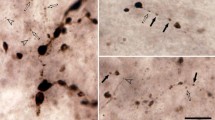Summary
The properties of trigeminal ganglion sensory neurones innervating the head skin of lateXenopus laevis embryos have been studied using extracellular recordings. Two types of mechanosensory neurones were found:Rapid-transient detectors which responded with few impulses to rapid, local, indentation of the skin with a fine probe (10–25 μm diameter), andMovement detectors which responded with a slowly adapting discharge to even very slow distortion of the skin (5 μm· s−1) with small or large probes. Receptive fields over the whole head surface as far back as the gill rudiments were plotted for both types of neurone. The areas for the two types were similar (means of 0.015 mm2 for rapid-transient and 0.017 mm2 for movement).
Comparative observations on embryos ofRana temporaria andTriturus helveticus showed a very similar division of trigeminal sensory neurones into two types. InXenopus embryos stimuli which only excite the movement detectors were found to have inhibitory effects on behaviour. They would stop swimming and responses to other excitatory stimuli. Stimuli which excited the rapid-transient detectors normally evoked swimming. The division of the somatosensory system inXenopus embryos into two subsystems with different sensitivities and inhibitory, or excitatory effects on behaviour is discussed and related to findings in other groups of animals.
Similar content being viewed by others
References
Burgess, P.R., Perl, E.R.: Cutaneous mechanoreceptors and nociceptors. In: Handbook of sensory physiology, Vol. II. Iggo, A. (ed.), pp. 29–78. Berlin, Heidelberg, New York: Springer 1973
Cambar, R., Marrot, Br.: Table chronologique du développement de la grenouille agile (Rana dalmatina Bon.). Bull. Biol. Fr. Belg.88, 168–177 (1954)
Corner, M.: Rhythmicity in the early swimming anuran larvae. J. Embryol. Exp. Morphol.12, 665–671 (1964)
Gallien, L., Bidaud, O.: Table chronologique du développement chezTriturus helveticus Razonmowsky. Bull. Soc. Zool. Fr.84, 22–32 (1959)
Gray, J., Lissmann, H.W., Pumphrey, R.J.: The mechanism of locomotion in the leech (Hirudo medicinalis Ray). J. Exp. Biol.15, 408–430 (1938)
Gray, J., Sand, A.: Spinal reflexes in the Dogfish,Scyllium canicula. J. Exp. Biol.13, 210–218 (1936)
Hunt, C.C., McIntyre, A.K.J.: Properties of cutaneous touch receptors in cat. J. Physiol. (London)153, 88–98 (1960a)
Hunt, C.C., McIntyre, A.K.J.: An analysis of fibre diameter and receptor characteristics of myelinated cutaneous afferent fibres in cat. J. Physiol. (London)153, 99–112 (1960b)
Magni, F., Pellegrino, M.: Neural mechanisms underlying the segmentai and generalized shortening reflexes in the leech. J. Comp. Physiol.124, 339–351 (1978)
Martin, A.R., Wickelgren, W.O.: Sensory cells in the spinal cord of the sea lamprey. J. Physiol. (London)212, 65–83 (1971)
Matthews, G., Wickelgren, W.O.: Trigeminal sensory neurons of the Sea Lamprey. J. Comp. Physiol.123, 329–333 (1978)
Nicholls, J.G., Baylor, D.A.: Specific modalities and receptive fields of sensory neurons in CNS of the leech. J. Neurophysiol.31, 740–756 (1968)
Nieuwkoop, P.D., Faber, J.: Normal tables ofXenopus laevis (Daudin). Amsterdam: North-Holland Publishing Co. 1956
Roberts, A.: The role of propagated skin impulses in the sensory system of young tadpoles. Z. Vergl. Physiol.75, 388–401 (1971)
Roberts, A.: Mechanisms for the excitation of ‘free nerve endings ’. Nature253, 737–738 (1975)
Roberts, A.: Pineal eye and behaviour inXenopus tadpoles. Nature273, 774–775 (1978)
Roberts, A., Blight, A.R.: Anatomy, physiology and behavioural role of sensory nerve endings in the cement gland of embryonicXenopus. Proc. R. Soc. (London) (Biol.)192, 111–127 (1975)
Roberts, A., Hayes, B.P.: The anatomy and function of ‘free’ nerve endings in an amphibian skin sensory system. Proc. R. Soc. (London) (Biol.)196, 415–429 (1977)
Roberts, A., Smyth, D.: The development of a dual touch sensory system in embryos of the amphibianXenopus laevis. J. Comp. Physiol.88, 31–42 (1974)
Roberts, A., Stirling, C.A.: The properties and propagation of a cardiac-like impulse in the skin of young tadpoles. Z. Vergl. Physiol.71, 295–310 (1971)
Whiting, H.P.: A study of the development of behaviour and of nervous structure in the embryos of fishes. Ph.D. thesis, University of Cambridge (1940)
Author information
Authors and Affiliations
Additional information
I thank the MRC for support.
Rights and permissions
About this article
Cite this article
Roberts, A. The function and role of two types of mechanoreceptive ‘free’ nerve endings in the head skin of amphibian embryos. J. Comp. Physiol. 135, 341–348 (1980). https://doi.org/10.1007/BF00657650
Accepted:
Issue Date:
DOI: https://doi.org/10.1007/BF00657650




